Related Research Articles

A laser is a device that emits light through a process of optical amplification based on the stimulated emission of electromagnetic radiation. The word laser is an anacronym that originated as an acronym for light amplification by stimulated emission of radiation. The first laser was built in 1960 by Theodore Maiman at Hughes Research Laboratories, based on theoretical work by Charles H. Townes and Arthur Leonard Schawlow.

Solar energy is radiant light and heat from the Sun that is harnessed using a range of technologies such as solar power to generate electricity, solar thermal energy, and solar architecture. It is an essential source of renewable energy, and its technologies are broadly characterized as either passive solar or active solar depending on how they capture and distribute solar energy or convert it into solar power. Active solar techniques include the use of photovoltaic systems, concentrated solar power, and solar water heating to harness the energy. Passive solar techniques include orienting a building to the Sun, selecting materials with favorable thermal mass or light-dispersing properties, and designing spaces that naturally circulate air.

A laser diode is a semiconductor device similar to a light-emitting diode in which a diode pumped directly with electrical current can create lasing conditions at the diode's junction.
Q-switching, sometimes known as giant pulse formation or Q-spoiling, is a technique by which a laser can be made to produce a pulsed output beam. The technique allows the production of light pulses with extremely high (gigawatt) peak power, much higher than would be produced by the same laser if it were operating in a continuous wave mode. Compared to modelocking, another technique for pulse generation with lasers, Q-switching leads to much lower pulse repetition rates, much higher pulse energies, and much longer pulse durations. The two techniques are sometimes applied together.

A dye laser is a laser that uses an organic dye as the lasing medium, usually as a liquid solution. Compared to gases and most solid state lasing media, a dye can usually be used for a much wider range of wavelengths, often spanning 50 to 100 nanometers or more. The wide bandwidth makes them particularly suitable for tunable lasers and pulsed lasers. The dye rhodamine 6G, for example, can be tuned from 635 nm (orangish-red) to 560 nm (greenish-yellow), and produce pulses as short as 16 femtoseconds. Moreover, the dye can be replaced by another type in order to generate an even broader range of wavelengths with the same laser, from the near-infrared to the near-ultraviolet, although this usually requires replacing other optical components in the laser as well, such as dielectric mirrors or pump lasers.
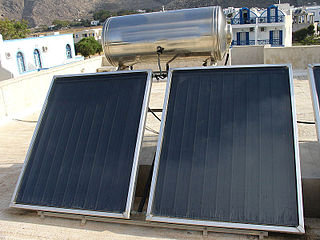
A solar thermal collector collects heat by absorbing sunlight. The term "solar collector" commonly refers to a device for solar hot water heating, but may refer to large power generating installations such as solar parabolic troughs and solar towers or non water heating devices such as solar cooker, solar air heaters.
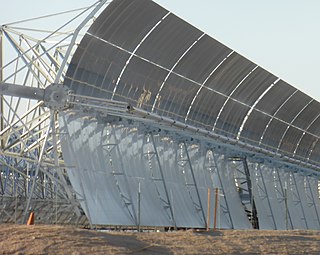
A parabolic trough is a type of solar thermal collector that is straight in one dimension and curved as a parabola in the other two, lined with a polished metal mirror. The sunlight which enters the mirror parallel to its plane of symmetry is focused along the focal line, where objects are positioned that are intended to be heated. In a solar cooker, for example, food is placed at the focal line of a trough, which is cooked when the trough is aimed so the Sun is in its plane of symmetry.

Many ceramic materials, both glassy and crystalline, have found use as optically transparent materials in various forms from bulk solid-state components to high surface area forms such as thin films, coatings, and fibers. Such devices have found widespread use for various applications in the electro-optical field including: optical fibers for guided lightwave transmission, optical switches, laser amplifiers and lenses, hosts for solid-state lasers and optical window materials for gas lasers, and infrared (IR) heat seeking devices for missile guidance systems and IR night vision. In commercial and general knowledge domains, it is commonly accepted that transparent ceramics or ceramic glass are varieties of strengthened glass, such as those used for the screen glass on an iPhone.

A solar mirror contains a substrate with a reflective layer for reflecting the solar energy, and in most cases an interference layer. This may be a planar mirror or parabolic arrays of solar mirrors used to achieve a substantially concentrated reflection factor for solar energy systems.
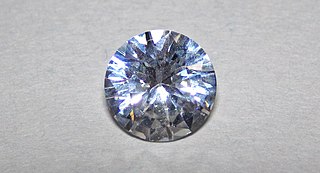
Yttrium aluminium garnet (YAG, Y3Al5O12) is a synthetic crystalline material of the garnet group. It is a cubic yttrium aluminium oxide phase, with other examples being YAlO3 (YAP) in a hexagonal or an orthorhombic, perovskite-like form, and the monoclinic Y4Al2O9 (YAM).
This is a list of solar energy topics.
The term quantum defect refers to two concepts: energy loss in lasers and energy levels in alkali elements. Both deal with quantum systems where matter interacts with light.

Laser pumping is the act of energy transfer from an external source into the gain medium of a laser. The energy is absorbed in the medium, producing excited states in its atoms. When for a period of time the number of particles in one excited state exceeds the number of particles in the ground state or a less-excited state, population inversion is achieved. In this condition, the mechanism of stimulated emission can take place and the medium can act as a laser or an optical amplifier. The pump power must be higher than the lasing threshold of the laser.

A ruby laser is a solid-state laser that uses a synthetic ruby crystal as its gain medium. The first working laser was a ruby laser made by Theodore H. "Ted" Maiman at Hughes Research Laboratories on May 16, 1960.
Neodymium-doped yttrium lithium fluoride (Nd:YLF) is a lasing medium for arc lamp-pumped and diode-pumped solid-state lasers. The YLF crystal (LiYF4) is naturally birefringent, and commonly used laser transitions occur at 1047 nm and 1053 nm.
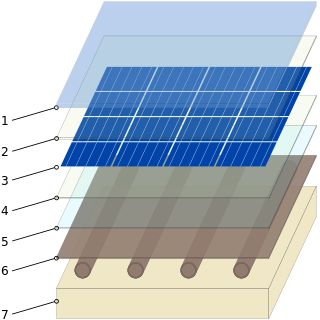
Photovoltaic thermal collectors, typically abbreviated as PVT collectors and also known as hybrid solar collectors, photovoltaic thermal solar collectors, PV/T collectors or solar cogeneration systems, are power generation technologies that convert solar radiation into usable thermal and electrical energy. PVT collectors combine photovoltaic solar cells, which convert sunlight into electricity, with a solar thermal collector, which transfers the otherwise unused waste heat from the PV module to a heat transfer fluid. By combining electricity and heat generation within the same component, these technologies can reach a higher overall efficiency than solar photovoltaic (PV) or solar thermal (T) alone.
The following outline is provided as an overview of and topical guide to solar energy:
The Fraunhofer Institute for Solar Energy Systems ISE is an institute of the Fraunhofer-Gesellschaft. Located in Freiburg, Germany, The Institute performs applied scientific and engineering research and development for all areas of solar energy. Fraunhofer ISE has three external branches in Germany which carry out work on solar cell and semiconductor material development: the Laboratory and Service Center (LSC) in Gelsenkirchen, the Technology Center of Semiconductor Materials (THM) in Freiberg, and the Fraunhofer Center for Silicon Photovoltaics (CSP) in Halle. From 2006 to 2016 Eicke Weber was the director of Fraunhofer ISE. With over 1,100 employees, Fraunhofer ISE is the largest institute for applied solar energy research in Europe. The 2012 Operational Budget including investments was 74.3 million euro.
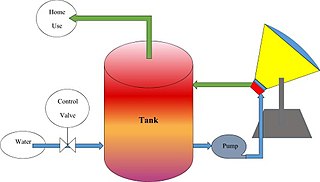
The combination of photovoltaic (PV) technology, solar thermal technology, and reflective or refractive solar concentrators has been a highly appealing option for developers and researchers since the late 1970s and early 1980s. The result is what is known as a concentrated photovoltaic thermal (CPVT) system which is a hybrid combination of concentrated photovoltaic (CPV) and photovoltaic thermal (PVT) systems.
References
- ↑ De Young et al. Preliminary Design and Cost of a 1-Megawatt Solar-Pumped Iodide Laser Space-to-Space Transmission Station, NASA Technical Memorandum, 1987 (Original version, WebCite archive), Retrieved 2011-06-23
- ↑ G.A. Landis, "New Approaches for a Solar-Pumped GaAs Laser," Optics Communications, 92, pp 261-265 (1992). (Abstract)
- ↑ I.M. Tsidulko, "Semiconductor Laser Pumped by Solar Radiation," Soviet Journal of Quantum Electronics 22 (5), pp. 463-466 (1992).
- ↑ Sh. D. Payziyeva; S. A. Bakhramov; A. K. Kasimov. "Transformation of concentrated sunlight into laser radiation on small parabolic concentrators". Journal of Renewable and Sustainable Energy . 3 (5). Scientific and Production Association “Akadempribor”, Tashkent 100125, Uzbekistan: American Institute of Physics.
{{cite journal}}: CS1 maint: location (link) - ↑ "Can Lasers Help Decrease Our Dependence on Fossil Fuels?". Archived from the original on 2016-05-15. Retrieved 2009-05-05.
- ↑ "Solar light pumped laser and cooling method of solar light pumped laser, USPTO Application #: 20080225912". Archived from the original on 2012-02-17. Retrieved 2009-05-05.
- ↑ Geoffrey A. Landis, "Prospects for Solar Pumped Semiconductor Lasers," Paper SPIE 2121-09, Laser Power Beaming, SPIE Proceedings Volume 2121, pp. 58-65, January 27–28, 1994 (web version access date 2009-11-10)
- ↑ I. Jiménez; S. Wallentowitz. "Intra-cavity laser-assisted solar-energy conversion". J. Opt. Soc. Am. B . 40 (8). Optical Society of America.
- ↑ Bakhramov, S.A.; Payziyev, Sh.D.; Klychev, Sh.I.; Kasimov, A.K.; Abdurakhmanov, A.A. (2005). "Laser on the big solar concentrator". Proceedings of CAOL 2005. Second International Conference on Advanced Optoelectronics and Lasers, 2005. Vol. 1. pp. 109–111. doi:10.1109/CAOL.2005.1553831. ISBN 0-7803-9130-6.
- ↑ "Parabolic mirrors concentrate sunlight to power lasers" . Retrieved 2019-08-13.
- ↑ Payziyev, Sh. D.; Bakhramov, S. A.; Kasimov, A. K. (2011). "Transformation of concentrated sunlight into laser radiation on small parabolic concentrators". Journal of Renewable and Sustainable Energy. 3 (5): 053102. doi:10.1063/1.3643267.
- 1 2 Duncan Graham-Rowe (September 19, 2007). "Solar-Powered Laser". MIT Technology Review .
- ↑ Applied Physics Letters (2007), cited in [12]


